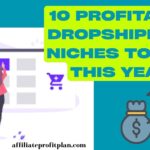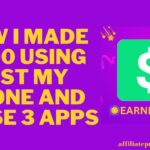Welcome to my article Affiliate Marketing for Bloggers: The Ultimate Guide. Imagine waking up, grabbing your morning coffee, checking your email, and—bam!—you see a commission notification. Someone, somewhere, clicked a link on your blog, bought a product, and you just made money while you slept. Sounds like a dream, right? Well, welcome to the world of affiliate marketing for bloggers, where passive income isn’t just a buzzword—it’s a real possibility.
In this ultimate guide, we’re going to break down everything you need to know—from picking the right affiliate programs to crafting high-converting content and driving traffic to your blog. Whether you’re a beginner looking to make your first dollar or a seasoned blogger aiming to scale your earnings, this guide has got you covered. So, let’s dive in and turn your blog into a revenue-generating machine—without the hard sell or shady tactics! 🚀
Access My Proven Blueprint for $50-$100 Daily Income – Watch This FREE Video Now >>>

Introduction to Affiliate Marketing for Bloggers
If you’ve ever raved about a product to a friend and thought, Wow, I should get paid for this, then congratulations—you already understand the basics of affiliate marketing. The only difference? Instead of just telling one friend, you’re telling hundreds (or thousands) of readers on your blog, and when they buy, you actually do get paid. Pretty sweet, right?
At its core, affiliate marketing is a commission-based system where bloggers promote products or services using unique tracking links. When someone clicks your link and makes a purchase, you earn a percentage of the sale—without handling inventory, customer service, or shipping. It’s basically passive income in digital form. But before you start picturing yourself on a beach, sipping a piña colada while your blog rakes in cash, let’s be real—affiliate marketing isn’t a get-rich-quick scheme. It takes effort, the right strategy, and a sprinkle of patience.
The beauty of affiliate marketing for bloggers is that it seamlessly integrates into your existing content. Whether you run a tech blog reviewing the latest gadgets, a food blog recommending kitchen tools, or a personal finance site sharing budgeting apps, there’s an affiliate program for just about everything. The trick is to promote products that are genuinely useful to your audience—because nothing screams “salesy” more than a beauty blogger suddenly pushing lawnmowers.
In the next sections, we’ll dive into how to choose the right affiliate programs, create high-converting content, and drive traffic to maximize your earnings. So, grab your coffee, because we’re about to turn your blog into a money-making powerhouse—without the cringe-worthy sales tactics. 🚀
Choosing the Right Affiliate Programs
So, you’re ready to dive into affiliate marketing—awesome! But before you start slapping links all over your blog like digital confetti, let’s talk about the most important step: choosing the right affiliate programs. Because trust me, not all programs are created equal, and picking the wrong ones can leave you frustrated, broke, and wondering why no one is clicking your links.
First things first: relevance is key. The best affiliate programs align with your niche and audience’s interests. If you run a fitness blog, promoting protein powders or workout gear makes sense. If you blog about minimalist living, pushing high-end luxury gadgets? Not so much. Readers can smell inauthenticity from a mile away, and nothing kills trust faster than recommending random products just for a commission.
Next, consider commission rates and cookie durations. Some programs, like Amazon Associates, offer lower commissions (typically 1-10%) but have a massive selection of products. Others, like web hosting or software companies, pay higher commissions (sometimes $50-$100+ per sale). Cookie duration matters too—some programs track sales for 30 to 90 days, while others (like Amazon) only give you credit if the purchase happens within 24 hours. The longer the cookie duration, the better your chances of earning commissions.
If you’re not sure where to start, here are some popular affiliate programs by category:
- E-commerce & Retail: Amazon Associates, Walmart, Etsy
- Tech & Software: Bluehost, Hostinger, Canva, Adobe
- Finance & Business: Fiverr, QuickBooks, FreshBooks
- Lifestyle & Beauty: Sephora, Ulta, RewardStyle
- Health & Fitness: MyProtein, Bowflex, Fitbit
And don’t forget about independent affiliate programs! Many brands run their own affiliate programs outside of big networks, often with better commissions. Just check a brand’s website—if they have an “Affiliate” or “Partner” page, you’re in business.
Bottom line? Choose programs that fit your niche, offer solid commissions, and provide real value to your readers. Because when you genuinely love what you promote, your audience will trust your recommendations—and that’s when the commissions start rolling in. 🚀
Creating High-Converting Affiliate Content
So, you’ve picked the perfect affiliate programs—awesome! But now comes the million-dollar question: how do you get people to actually click your links and buy? The answer? You need high-converting affiliate content—the kind that doesn’t scream BUY THIS NOW, but instead makes readers feel like they need the product in their lives.
Access My Proven Blueprint for $50-$100 Daily Income – Watch This FREE Video Now >>>
1. Choose the Right Content Format
Not all blog posts are created equal when it comes to affiliate marketing. Some content types naturally perform better than others. Here are the top-performing formats:
- Product Reviews: Honest, in-depth reviews where you share your personal experience with a product. People love reading these before making a purchase.
- Comparison Posts: “X vs. Y” style posts help readers decide between two or more products (e.g., Bluehost vs. SiteGround: Which Hosting is Better?).
- Tutorials & How-To Guides: Walk readers through using a product. Example: How to Start a Blog with WordPress (Step-by-Step Guide), where you recommend hosting services.
- Listicles & Roundups: Example: 10 Must-Have Blogging Tools for Beginners (with affiliate links to each tool).
- Case Studies & Personal Stories: Readers love real-life experiences! If a product has genuinely helped you, share the journey.
2. Write for Value, Not Just Sales
Nobody likes a pushy salesperson. Your goal should be to educate and help your readers first—the sales will follow naturally. Instead of saying:
🚫 “This is the best web hosting service! Click my link to buy now!”
Try:
✅ “I tested multiple web hosting services, and [Hosting X] had the best speed, uptime, and support. Here’s why I recommend it for bloggers.”
See the difference? Authenticity builds trust, and trust leads to conversions.
3. Optimize for SEO (So People Actually Find Your Content)
Even the best affiliate content won’t convert if no one reads it. Here’s how to make sure your posts rank on Google:
- Use long-tail keywords (e.g., best budget laptop for students instead of just best laptop).
- Answer common questions (people search for “Is [Product X] worth it?”—so include it in your content!).
- Write compelling meta descriptions to increase click-through rates.
- Add internal links to keep readers on your site longer.
4. Use Strong Call-to-Actions (CTAs) That Feel Natural
If you don’t ask, you don’t get. But your CTAs should feel organic and persuasive. Instead of “Click here to buy,” try:
✅ “Want faster website loading times? Check out [Hosting X]—it boosted my speed by 40%!”
Pro tip: Use buttons, bold text, or comparison tables to highlight affiliate links instead of burying them in paragraphs.
5. Track, Test, and Improve
Not all affiliate content will be a home run, and that’s okay. Use tools like Google Analytics and affiliate dashboards to track which posts and links are driving the most sales. If something isn’t converting, tweak your approach—maybe change the CTA, update the content, or try a different format.
Final Thoughts
Creating high-converting affiliate content isn’t about aggressive selling—it’s about helping your audience make informed decisions. Provide value, be honest, and optimize your content for both SEO and user experience. Do this consistently, and you’ll start seeing those sweet commission notifications rolling in. 🚀💰
SEO and Traffic Strategies for Affiliate Blogs
You could have the most well-written, persuasive affiliate content in the world, but if no one sees it… well, your commission balance is going to look pretty sad. 😢 That’s why SEO (Search Engine Optimization) and traffic generation are absolutely crucial for affiliate bloggers. The goal? Get your blog in front of the right people—the ones who are actively searching for the products you’re promoting.
So, how do you bring in highly targeted, ready-to-buy traffic to your affiliate blog? Let’s break it down.
1. Master Keyword Research (Because Google Loves Specificity)
SEO starts with understanding what your audience is searching for. You don’t just want traffic—you want buyer intent traffic (a.k.a. people who are already looking for what you’re recommending).
🔍 Best keyword types for affiliate blogs:
✅ Product-focused keywords – “Best budget gaming laptop 2025”
✅ Comparison keywords – “iPhone vs. Samsung: Which is better?”
✅ Review keywords – “XYZ Software Review: Pros & Cons”
✅ Tutorial keywords – “How to start a blog with Bluehost”
🚀 Pro tip: Use free tools like Google’s Keyword Planner, Ubersuggest, and AnswerThePublic to find keywords with decent search volume but lower competition.
2. Optimize Your Blog Posts for Search Engines
Once you’ve nailed down the right keywords, it’s time to optimize your content so Google (and your readers) love it. Here’s the game plan:
📌 On-Page SEO Checklist:
✅ Use your primary keyword in the title, URL, first 100 words, and headers (naturally, no keyword stuffing!).
✅ Write an SEO-friendly meta description—make it engaging so people actually click!
✅ Use internal linking (link to related blog posts) to improve site navigation and keep readers on your site longer.
✅ Optimize images with alt text (bonus: faster-loading images improve user experience).
✅ Structure your content with bullet points and short paragraphs for readability.
3. Leverage Social Media & Pinterest for Free Traffic
Social media might not be your main traffic source, but it can give your blog posts a serious boost.
📌 Where to focus:
- Pinterest: The holy grail for bloggers. Create eye-catching pins for each post, use relevant keywords in descriptions, and join group boards for extra exposure.
- Facebook Groups: Find niche-related groups where you can share your expertise (not just links!).
- Twitter & LinkedIn: Great for networking and driving traffic from industry-related conversations.
- YouTube & TikTok: If you’re comfortable on camera, create quick reviews or tutorials and direct viewers to your blog.
🚀 Pro tip: Automate your social sharing with tools like Tailwind (for Pinterest) or Buffer to stay consistent.
4. Build Backlinks (A.K.A. Get Google to Trust You More)
Google ranks sites based on authority, and backlinks (other sites linking to you) boost your credibility. The more high-quality sites linking to your content, the better your chances of ranking higher.
🔥 How to build backlinks:
✅ Guest posting on reputable blogs in your niche.
✅ Answering questions on Quora/Reddit and linking back to relevant blog posts.
✅ Networking with other bloggers for link swaps or mentions.
✅ Creating shareable content (e.g., ultimate guides, infographics, case studies).
🚀 Pro tip: Don’t buy shady backlinks. Google will find out, and it won’t be pretty.
5. Build an Email List (So You’re Not at Google’s Mercy)
SEO is amazing, but algorithms change (looking at you, Google updates). That’s why building an email list is one of the smartest things you can do. Once you have subscribers, you can send traffic to your affiliate content whenever you want.
📌 How to grow your email list:
- Offer a freebie (e.g., checklist, eBook, discount code) in exchange for email sign-ups.
- Add opt-in forms throughout your blog (sidebar, pop-ups, after blog posts).
- Send value-packed newsletters with product recommendations & helpful tips.
🚀 Pro tip: Use tools like ConvertKit or MailerLite to set up automated email sequences that nurture your audience and drive affiliate sales.
Final Thoughts
Affiliate marketing isn’t just about writing great content—it’s about getting eyeballs on that content. By focusing on SEO, social media, backlinks, and email marketing, you can build a steady stream of organic, targeted traffic that turns your blog into a commission-generating machine.
Now go forth and get those clicks—Google (and your bank account) will thank you. 🚀💰
Avoiding Common Mistakes & Maximizing Earnings
So, you’ve got your affiliate links in place, your SEO game is strong, and you’re patiently waiting for the commissions to roll in. But wait—why isn’t anyone clicking? Or worse, why are they clicking but not buying? 😨 If this sounds familiar, don’t panic! Many bloggers unknowingly make mistakes that sabotage their affiliate earnings. The good news? Most of these mistakes are easy to fix once you know what to watch out for.
Let’s break down the biggest affiliate marketing mistakes bloggers make—and how to avoid them—so you can maximize your earnings like a pro.
1. Promoting Too Many (or the Wrong) Products
One of the biggest rookie mistakes? Throwing in affiliate links for anything and everything. If your blog looks like an online flea market—packed with random, unrelated products—readers will trust you less, not more.
🔴 What NOT to do:
🚫 Promoting products just because they have high commissions.
🚫 Using affiliate links for products you’ve never used or wouldn’t recommend.
🚫 Linking to every possible product in a single blog post.
✅ What TO do:
✔ Only promote products that align with your niche and that your audience actually needs.
✔ Focus on quality over quantity—it’s better to deeply promote a few high-converting products than link to dozens that no one buys.
✔ If possible, test the products yourself and share your real experience—it builds trust!
2. Ignoring Disclosure Rules (Yes, the FTC is Watching 👀)
Affiliate marketing isn’t the Wild West—you must disclose your affiliate relationships to stay compliant with FTC guidelines. Not doing so can lead to legal trouble, lost credibility, and even bans from affiliate programs.
🔴 What NOT to do:
🚫 Hiding or completely skipping the disclosure.
🚫 Burying the disclosure at the bottom where no one sees it.
✅ What TO do:
✔ Clearly state at the top of your blog post that it contains affiliate links. Example:
“This post contains affiliate links. If you purchase through these links, I may earn a small commission at no extra cost to you.”
✔ Use plain language—your readers should understand it, not feel like they’re reading legal jargon.
✔ If you’re promoting on social media, #ad or #affiliate in your post is a good practice.
3. Not Using Proper Link Placement & CTAs
Just dropping affiliate links in your blog posts like Easter eggs won’t cut it. You need to strategically place them so they actually get clicked.
🔴 What NOT to do:
🚫 Hiding links in long paragraphs where they blend in.
🚫 Only using raw affiliate links (ugly, untrackable, and untrustworthy).
✅ What TO do:
✔ Place affiliate links in high-visibility areas—within the first few paragraphs, inside subheadings, and at the end of posts.
✔ Use clear call-to-actions (CTAs) instead of just dumping links. Example:
✅ “I’ve been using [Product X] for months, and it’s completely changed my workflow. Check it out here!”
✔ Use buttons instead of plain text links for better visibility. Example:
🟢 “Get 10% Off [Product Name] →”
✔ Cloak your links with tools like Pretty Links or ThirstyAffiliates to make them look cleaner (e.g., yourblog.com/recommends/tool instead of long-ugly-affiliatelink.com).
4. Forgetting to Track & Optimize Performance
You wouldn’t drive a car without checking the fuel gauge—so why run an affiliate blog without tracking your clicks, conversions, and commissions? Without tracking, you have no idea which strategies are working and which need improvement.
🔴 What NOT to do:
🚫 Just adding links and hoping for the best.
🚫 Sticking with low-performing affiliate programs instead of testing new ones.
✅ What TO do:
✔ Use Google Analytics to track which blog posts are bringing in the most affiliate traffic.
✔ Check your affiliate dashboard regularly—look at click-through rates (CTR) and conversion rates.
✔ A/B test different CTAs, link placements, and product recommendations to see what converts best.
✔ If an affiliate program isn’t performing well, test an alternative one with a better commission structure.
5. Giving Up Too Soon (Affiliate Marketing Takes Time!)
Here’s a hard truth: Affiliate marketing isn’t an overnight success game. Many bloggers quit too early because they expect instant results. The reality? It takes time to build trust, grow traffic, and optimize for conversions.
🔴 What NOT to do:
🚫 Expecting to make thousands of dollars in your first month.
🚫 Quitting because your first few blog posts didn’t generate sales.
✅ What TO do:
✔ Be consistent—keep publishing valuable, SEO-optimized affiliate content.
✔ Improve your content promotion strategy (social media, email marketing, Pinterest).
✔ Keep testing different affiliate programs—sometimes a simple switch can boost your earnings.
✔ Understand that trust takes time—once your audience sees you as a reliable source, conversions will improve.
Final Thoughts: Play the Long Game & Scale Your Earnings
Affiliate marketing is one of the most powerful ways to monetize a blog—but only if you do it the right way. Avoid common mistakes like promoting random products, ignoring SEO, and skipping disclosures. Instead, focus on trust, value, and strategic optimization.
And remember: Success doesn’t happen overnight, but the effort is 100% worth it. Stay patient, keep testing, and soon enough, you’ll start seeing those commission notifications roll in. 🚀💰
Now, go forth and optimize those affiliate links like a pro! 😉
Conclusion: Your Affiliate Marketing Journey Starts Now 🚀
Phew! We’ve covered a lot, haven’t we? From understanding the basics of affiliate marketing for bloggers to choosing the right programs, creating high-converting content, mastering SEO, and avoiding common pitfalls—you’re now armed with everything you need to turn your blog into a money-making machine.
Access My Proven Blueprint for $50-$100 Daily Income – Watch This FREE Video Now >>>
But let’s be real for a second. Affiliate marketing isn’t a get-rich-quick scheme. It takes time, patience, and a whole lot of testing. You won’t wake up tomorrow to a flood of commissions (though that would be nice, right?). Instead, think of it like planting seeds. The more effort you put into creating quality content, driving traffic, and building trust with your audience, the more those seeds will grow—and eventually, your blog will start generating passive income.
Here’s a quick recap of what you need to do next:
✅ Pick relevant, high-converting affiliate programs that align with your niche.
✅ Write valuable, engaging content that naturally integrates affiliate links.
✅ Optimize your blog posts for SEO and user experience to get more traffic.
✅ Use smart promotion strategies (social media, email lists, backlinks).
✅ Track your performance and tweak what’s not working.
Most importantly, stay consistent. Affiliate marketing success doesn’t happen overnight, but if you keep showing up, refining your strategy, and providing real value, you’ll start to see those commission notifications roll in. And trust me, nothing beats the feeling of earning money while you sleep. 😏💰
So, what are you waiting for? Go apply what you’ve learned, start optimizing your blog for affiliate marketing, and watch your earnings grow! 🚀
Thanks a lot for reading my article on “Affiliate Marketing for Bloggers: The Ultimate Guide” till the end. Hope you’ve helped. See you with another article.










